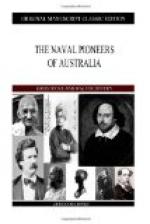During the 122 years of which we have records of their voyages, although the Dutch navigators’ work, compared with that done by Cook and his successors, was of small account; yet, considering the state of nautical science, and that the ships were for the most part Dutch East Indiamen, the Dutch names which still sprinkle the north and the west coasts of the continent show that from Cape York in the extreme north, westward of the Great Australian Bight in the south, the Dutchmen had touched at intervals the whole coast-line.
But before leaving the Dutch period there are one or two voyages that, either on account of their interesting or important character, deserve brief mention.
In 1623 Arnhem’s Land, now the northern district of the Northern Territory of South Australia, was discovered by the Dutch yachts Pesa and Arnhem. This voyage is also noteworthy on account of the massacre of the master of the Arnhem and eight of his crew by the natives while they were exploring the coast of New Guinea. In 1627 the first discovery of the south coast was made by the Gulde Zeepard, and the land then explored, extending from Cape Leeuwin to the Nuyts Archipelago, on the South Australian coast, was named after Peter Nuyts, then on board the ship on his way to Batavia, whence he was sent to Japan as ambassador from Holland.
In the year 1628 a colonizing expedition of eleven vessels left Holland for the Dutch East Indies. Among these ships was the Batavia, commanded by Francis Pelsart. A terrible storm destroyed ten of the fleet, and on June 4th, 1629, the Batavia was driven ashore on the reef still known as Houtman’s Abrolhos, which had been discovered and named by a Dutch East Indiaman some years earlier—probably by the commander of the Leeuwin, who discovered and named after his ship the cape at the south-west point of the continent. The Batavia, which carried a number of chests of silver money, went to pieces on the reef. The crew of the ship managed to land upon the rocks, and saved some food from the wreck, but they were without water. Pelsart, in one of the ship’s boats, spent a couple of weeks exploring the inhospitable coast in the neighbourhood in the hope of discovering water, but found so little that he ultimately determined to attempt to make Batavia and from there bring [Sidenote: 1629] succour to his ship’s company. On July 3rd he fell in with a Dutch ship off Java and was taken on to Batavia. From there he obtained help and returned to the wreck, arriving at the Abrolhos in the middle of September; but during the absence of the commander the castaways had gone through a terrible experience, which is related in Therenot’s Recueil de Voyages Curieux, and translated into English in Major’s book, from which the following is extracted:—




